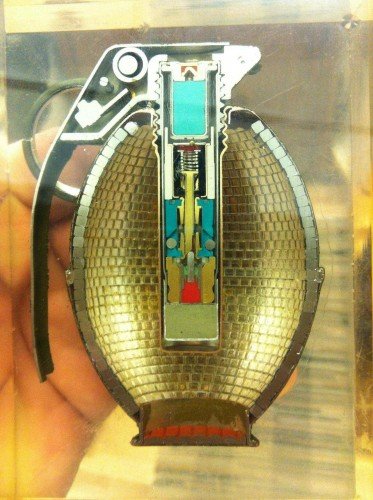Hand Engineering Granada

Granada is a small pump designed for use in walking distance. The idea is very simple: a combustible material is ignited to produce an explosion - the gas spread very rapidly producing strong outward pressure. The essential elements of a grenade are the fuel material and the ignition system. Ignition systems may be of two categories: time igniter or igniters impact. The two function is to cause the explosion after the grenade is a good distance from the pitcher. The igniter in an impact grenade is activated by the force of the landing of the grenade on the ground. With a timed grenade thrower triggers a trigger mechanism that detonates the grenade after a certain time (usually after a few seconds). In timed grenade firing mechanism is triggered by a spring-loaded inside the grenade. Typically, the firing pin is held in place by the striker lever on top of the grenade held in position by a safety pin. The soldier grips the grenade, so that the striker lever is pushed up, pulls out the pin and throws the grenade. Here's what happens inside once the grenade is released: with the pin removed, nothing holding the lever in place, which means that nothing holds the firing pin spring-loaded. Spring triggers the hammer down against the cap. The impact ignites the cap, creating a small spark; The spark ignites a slow-burning material in the fuze. In about four seconds, the delay material burns completely; the end of the delay element is connected to the detonator a capsule filled with more fuel material. The burning material at the end of the delay ignites the material in the detonator, causing an explosion inside the grenade; the explosion ignites the explosive material around, creating a much larger explosion that shatters the grenade; the outer casing of pieces of metal flying at high speed, digging in all that is within your reach. This type of grenade may contain additional serrated wire or metal pellets for increased damage resulting from fragmentation. Impact grenades must remain unarmed until they are actually fired, because any accidental contact can detonate them. Since they are usually fired from a launcher, must have a system of automatic arming. In some designs, the arming system is triggered by the propellant explosion that drives the grenade out of the launcher. In other designs, the grenade's acceleration or rotation during its flight arms the detonator.

The grenade has an aerodynamic design, with a nose, a tail and two flight fins. The impact trigger, the grenade nose, consists of a movable panel mounted with a spring and firing pin facing inward. As in timed grenade, the fuze mechanism has a fuse and an explosive detonator ignites the main explosive. But it does not include a chemical retardant element. When the grenade is disarmed, the fuze mechanism is positioned towards the tail, despite having a spring that pushes toward the nose. It is kept in this position for several balance pins mounted with springs. The firing pin is not long enough to reach the fuze when the fuze is in this position. If the trigger plate is pressed accidentally, the pin will slide back and forth in the air and nothing will happen. When the grenade is thrown it starts spinning. This movement is caused by the shape and position of the flaps, as well as spiraled grooves within the grenade launcher barrel. The rotary motion of the grenade generates a large centrifugal force that pushes the balance pins out. When they move away enough, they release the fuze mechanism, jumping forward toward the nose of the grenade. When the grenade hits the ground, the nose plate is forced inward, driving the firing pin against the cap. The cap explodes, causing the ignition of explosive detonator and, consequently, the main explosive.
Upvoted
Good article